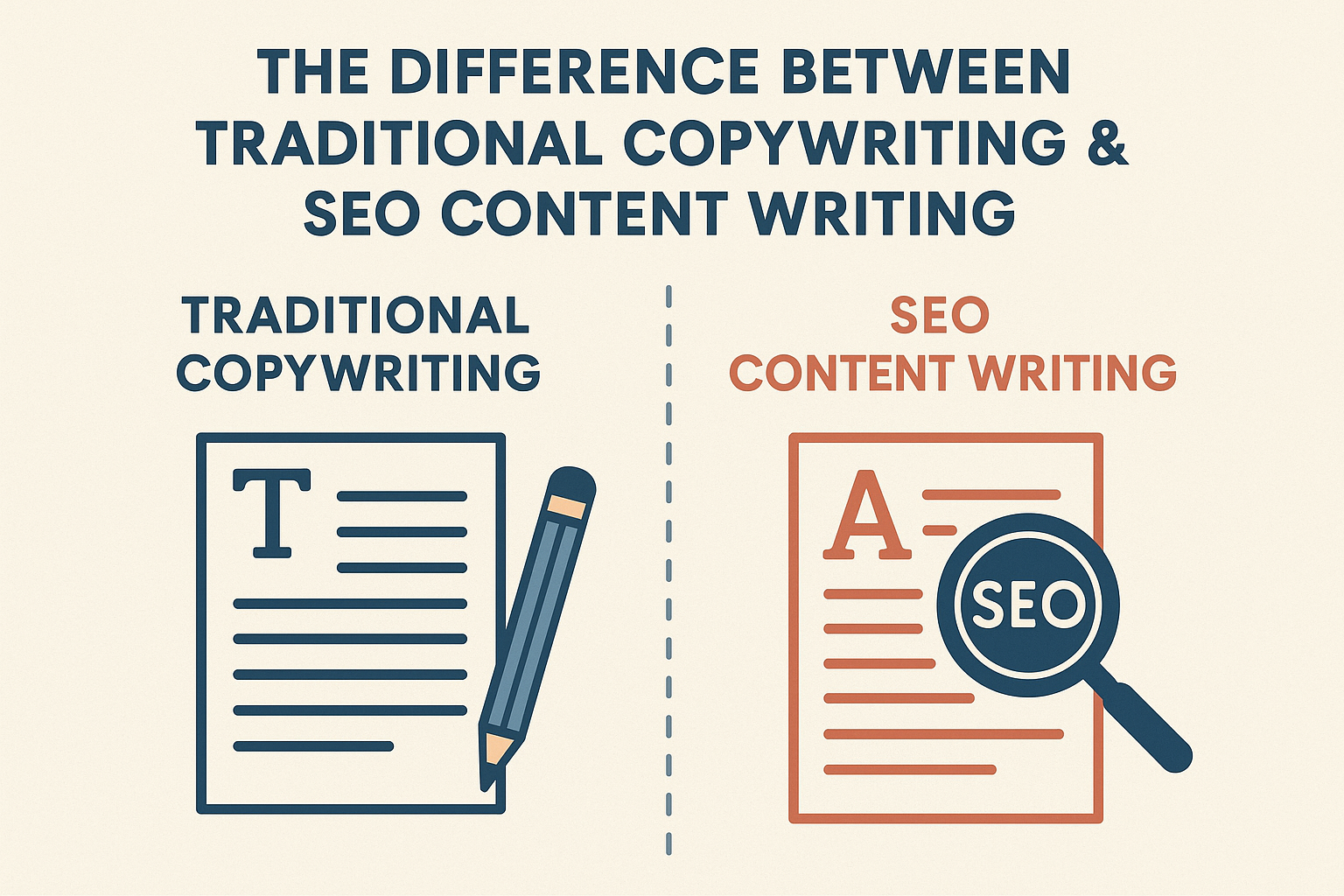In the age of content saturation, not all writing is created equal. While every business knows the value of words—be it for websites, blogs, or branding—few realize that the type of writing used can make or break their digital success.
That’s why understanding the distinction between SEO content writing and traditional copywriting is so crucial. Whether you’re working with an in-house team, outsourcing to agencies, or collaborating with professional ghostwriters, knowing what kind of writer you need is the first step to achieving your marketing goals.
Though both writing styles aim to inform, persuade, or convert, they differ in approach, structure, audience targeting, and outcomes. Let’s explore what sets them apart—and when to use each.
What Is SEO Content Writing?
SEO content writing focuses on crafting content that ranks well in search engines. The goal is to gain and engage organic traffic by producing helpful, keyword-rich, and search-intent-optimized material. Think blog posts, pillar pages, how-to guides, tutorials, or even FAQs—all crafted with both readers and Google in mind.
Key Characteristics:
- Focuses on long-form educational or informative content
- Optimized for keywords and search intent
- Includes structured headers (H1, H2, H3)
- Designed to improve visibility and engagement over time
- Targets a specific topic cluster or SEO strategy
Great SEO content writing delivers consistent traffic, answers audience questions, and nurtures leads over time. Many professional ghostwriters today specialize in SEO to help brands build online authority without sacrificing voice or readability.
What Is Traditional Copywriting?
Copywriting, in its classic form, is the art of writing to sell. It’s all about conversion—getting the reader to take immediate action, whether that’s making a purchase, signing up, or clicking a link.
Key Characteristics:
- Emotionally driven and concise
- Often seen in ads, landing pages, product descriptions, and emails
- Prioritizes persuasive language and calls to action (CTAs)
- Focuses on brand identity and tone
- Designed to convert readers into customers quickly
Unlike SEO content, which plays a long game, traditional copywriting is about making a powerful impression in a short space. This type of writing is rooted in psychology and marketing rather than search performance.
SEO Writing vs. Copywriting: The 5 Core Differences
-
Purpose and Intent
The primary goal of SEO content is visibility. It’s meant to educate, inform, and build trust with the audience. It’s strategic and built to drive traffic and support long-term engagement.
Copywriting, however, is all about action. The content is crafted to elicit an emotional response, create urgency, and move the reader to click, buy, or sign up.
You can think of SEO content as nurturing and copywriting as closing.
-
Audience Targeting and Journey Stage
SEO content writing typically speaks to readers at the top or middle of the sales funnel. These are people seeking information or solutions but may not yet be ready to convert.
Copywriting targets users at the bottom of the funnel—those closer to a decision point. It’s tailored to speak directly to needs, pain points, and benefits in a fast-paced, results-oriented tone.
This is why many marketing teams employ professional ghostwriters with dual skill sets: one to guide and one to convert.
-
Style and Tone
SEO writing prioritizes clarity, structure, and keyword relevance. It’s written for both humans and algorithms, meaning the tone must balance natural readability with optimization.
Traditional copywriting, by contrast, leans heavily on brand voice and emotional resonance. It’s punchier, sometimes poetic, and highly intentional in word choice.
Example:
- SEO content might say: “Here are 10 ways to improve your writing productivity.”
- Copywriting might say: “Write more, stress less—unlock your creative flow today.”
Both styles have merit, but their applications differ significantly.
-
Optimization Techniques
SEO content writers are expected to:
- Conduct keyword research
- Use internal and external links strategically
- Format content using proper heading hierarchy
- Optimize metadata and alt text
- Ensure readability and skimmability
Copywriters focus on:
- Headlines that hook
- Unique value propositions (UVPs)
- Calls to action (CTAs)
- Storytelling and brand differentiation
- Conversion copy techniques (like AIDA, PAS)
An SEO article may take longer to write and rank, while a well-crafted landing page can convert traffic instantly with just a few lines.
-
Measuring Success
For SEO content, success is measured in:
- Organic traffic growth
- Time on page
- Backlinks and shares
- SERP rankings
- Lead nurturing
For copywriting, metrics include:
- Conversion rate
- Click-through rate (CTR)
- Bounce rate (from landing pages)
- Sales generated
- Engagement rate (from ads or emails)
Both roles are measurable—but their KPIs are completely different.
When Do You Need SEO Content Writing?
Choose SEO writing when:
- You’re building out a blog or resource center
- You want to improve your domain authority
- You’re targeting keywords and organic growth
- You need to build brand trust and educate your audience
- You plan to use content as a long-term traffic driver
For authors, coaches, SaaS brands, and service providers, SEO blogs can also support inbound lead generation. Many hire professional ghostwriters to build these libraries efficiently without sacrificing quality or voice.
When Do You Need Copywriting?
Use copywriting when:
- You’re launching a product or service
- You need a high-converting landing page
- You’re writing sales emails, Facebook ads, or PPC campaigns
- Your main goal is to drive action, not educate
- You’re rebranding and need a consistent voice across channels
This is where storytelling meets strategy—and where every word is engineered to convert. For businesses that rely on paid traffic or email funnels, a great copywriter is non-negotiable.
Can One Person Do Both?
In short, yes, but it’s rare.
Most skilled writers lean toward one style or the other. However, some professional ghostwriters are cross-trained in both SEO and copywriting—making them invaluable assets for growing brands that need both reach and response.
The Sweet Spot: SEO Copywriting
There’s also a growing hybrid model called SEO copywriting. This is content written to rank and convert. Examples include:
- Product pages that target keywords but drive sales
- Optimized service pages that include trust signals and CTAs
- Blog posts with strong calls to action or lead magnets
- Homepages designed for SEO and user experience
SEO copywriting is complex and strategic—but when done right, it delivers both traffic and conversions.
Final Thoughts
Understanding the difference between SEO content writing and traditional copywriting isn’t just a technical distinction—it’s a strategic decision. Use SEO content to build relationships and authority, and use copywriting to convert leads into customers.
At BookPlanets, we work with expert professional ghostwriters who specialize in both disciplines. It doesn’t matter if you’re building a brand, selling a product, or telling your story; we match you with writers who understand the tone, style, and intent needed to meet your goals.

